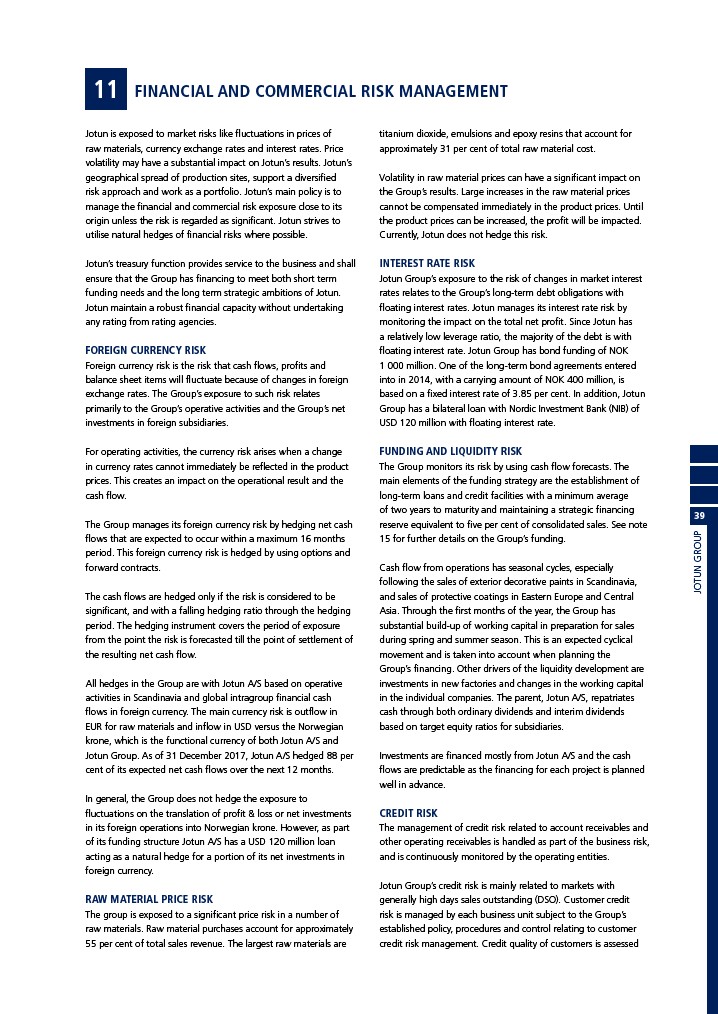
39
JOTUN GROUP
11 FINANCIAL AND COMMERCIAL RISK MANAGEMENT
Jotun is exposed to market risks like fluctuations in prices of
raw materials, currency exchange rates and interest rates. Price
volatility may have a substantial impact on Jotun’s results. Jotun’s
geographical spread of production sites, support a diversified
risk approach and work as a portfolio. Jotun’s main policy is to
manage the financial and commercial risk exposure close to its
origin unless the risk is regarded as significant. Jotun strives to
utilise natural hedges of financial risks where possible.
Jotun’s treasury function provides service to the business and shall
ensure that the Group has financing to meet both short term
funding needs and the long term strategic ambitions of Jotun.
Jotun maintain a robust financial capacity without undertaking
any rating from rating agencies.
FOREIGN CURRENCY RISK
Foreign currency risk is the risk that cash flows, profits and
balance sheet items will fluctuate because of changes in foreign
exchange rates. The Group’s exposure to such risk relates
primarily to the Group’s operative activities and the Group’s net
investments in foreign subsidiaries.
For operating activities, the currency risk arises when a change
in currency rates cannot immediately be reflected in the product
prices. This creates an impact on the operational result and the
cash flow.
The Group manages its foreign currency risk by hedging net cash
flows that are expected to occur within a maximum 16 months
period. This foreign currency risk is hedged by using options and
forward contracts.
The cash flows are hedged only if the risk is considered to be
significant, and with a falling hedging ratio through the hedging
period. The hedging instrument covers the period of exposure
from the point the risk is forecasted till the point of settlement of
the resulting net cash flow.
All hedges in the Group are with Jotun A/S based on operative
activities in Scandinavia and global intragroup financial cash
flows in foreign currency. The main currency risk is outflow in
EUR for raw materials and inflow in USD versus the Norwegian
krone, which is the functional currency of both Jotun A/S and
Jotun Group. As of 31 December 2017, Jotun A/S hedged 88 per
cent of its expected net cash flows over the next 12 months.
In general, the Group does not hedge the exposure to
fluctuations on the translation of profit & loss or net investments
in its foreign operations into Norwegian krone. However, as part
of its funding structure Jotun A/S has a USD 120 million loan
acting as a natural hedge for a portion of its net investments in
foreign currency.
RAW MATERIAL PRICE RISK
The group is exposed to a significant price risk in a number of
raw materials. Raw material purchases account for approximately
55 per cent of total sales revenue. The largest raw materials are
titanium dioxide, emulsions and epoxy resins that account for
approximately 31 per cent of total raw material cost.
Volatility in raw material prices can have a significant impact on
the Group’s results. Large increases in the raw material prices
cannot be compensated immediately in the product prices. Until
the product prices can be increased, the profit will be impacted.
Currently, Jotun does not hedge this risk.
INTEREST RATE RISK
Jotun Group’s exposure to the risk of changes in market interest
rates relates to the Group’s long-term debt obligations with
floating interest rates. Jotun manages its interest rate risk by
monitoring the impact on the total net profit. Since Jotun has
a relatively low leverage ratio, the majority of the debt is with
floating interest rate. Jotun Group has bond funding of NOK
1 000 million. One of the long-term bond agreements entered
into in 2014, with a carrying amount of NOK 400 million, is
based on a fixed interest rate of 3.85 per cent. In addition, Jotun
Group has a bilateral loan with Nordic Investment Bank (NIB) of
USD 120 million with floating interest rate.
FUNDING AND LIQUIDITY RISK
The Group monitors its risk by using cash flow forecasts. The
main elements of the funding strategy are the establishment of
long-term loans and credit facilities with a minimum average
of two years to maturity and maintaining a strategic financing
reserve equivalent to five per cent of consolidated sales. See note
15 for further details on the Group’s funding.
Cash flow from operations has seasonal cycles, especially
following the sales of exterior decorative paints in Scandinavia,
and sales of protective coatings in Eastern Europe and Central
Asia. Through the first months of the year, the Group has
substantial build-up of working capital in preparation for sales
during spring and summer season. This is an expected cyclical
movement and is taken into account when planning the
Group’s financing. Other drivers of the liquidity development are
investments in new factories and changes in the working capital
in the individual companies. The parent, Jotun A/S, repatriates
cash through both ordinary dividends and interim dividends
based on target equity ratios for subsidiaries.
Investments are financed mostly from Jotun A/S and the cash
flows are predictable as the financing for each project is planned
well in advance.
CREDIT RISK
The management of credit risk related to account receivables and
other operating receivables is handled as part of the business risk,
and is continuously monitored by the operating entities.
Jotun Group’s credit risk is mainly related to markets with
generally high days sales outstanding (DSO). Customer credit
risk is managed by each business unit subject to the Group’s
established policy, procedures and control relating to customer
credit risk management. Credit quality of customers is assessed